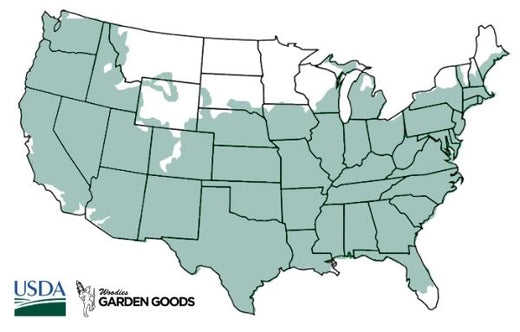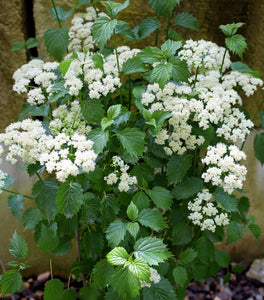Images Depict Mature Plants
Viburnum Winterthur Shrubs for Sale Online
Viburnum Winterthur (Viburnum nudum) is a deciduous flowering shrub with 3 seasons of interest. In spring, white flower clusters emerge to join the glossy green foliage that adorns this mounding shrub. With time, the white flowers darken to pinkish-red in the summer. However, the real show happens in the fall when the flowers transform to a brilliant blue color as the green foliage becomes a bronzy red for a beautiful and colorful contrast. Only when the leaves drop in the winter does this plant become inconspicuous.
Native to the Eastern United States, the Winterthur Smooth Viburnum can be found in moist soils of woodland and rustic gardens where it thrives in hardiness zones 5 through 9. The fragrant flowers attract pollinators and the berries are a favorite among birds, but may cause slight stomach irritation if ingested by humans.
For optimal blooms, plant the Winterthur Viburnum in full or partial sun. When they are planted among other Viburnum nudum cultivars, the number of blooms increases once more. This makes the Viburnum plant perfect when planted in mass. It can grow up to 10 feet tall and 6 feet wide, making it ideal for privacy hedges.
Some things to keep in mind when caring for the Winterthur Viburnum is that they do not do well in chalky or alkaline soils, but are wildly tolerant of damp soils. If pruning is needed, it is best to wait until the flowering season ends and take care not to heavily prune this bush as it may limit the number of blooms produced the following season.
| Hardiness Zone: | 5-9 |
|---|---|
| Mature Height: | 5 to 6 feet |
| Mature Width: | 5 to 6 feet |
| Classification: | Broad leaved deciduous shrub, summer flowering |
| Sunlight: | Full to partial sun |
| Habit: | Upright, densely branched |
| Foliage: | Dark Green |
| Flower Color: | White |
| Pruning Season: | Prune in late winter, flowers on new wood |
| Soil Condition: | Any well drained soil |
| Water Requirements: | Water well until established |
| Uses: | Extremely attractive when used as a focal point in the mixed border, mass planting, or a specimen planting |















